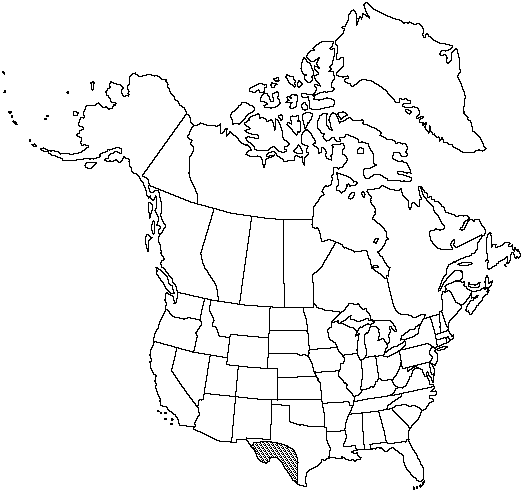Difference between revisions of "Notholaena nealleyi"
Contr. U.S. Natl. Herb. 1: 61. 1890.
FNA>Volume Importer |
imported>Volume Importer |
||
| (7 intermediate revisions by 2 users not shown) | |||
| Line 11: | Line 11: | ||
|name=Cheilanthes nealleyi | |name=Cheilanthes nealleyi | ||
|authority=(Seaton ex J. M. Coulter) Domin | |authority=(Seaton ex J. M. Coulter) Domin | ||
| − | }}{{Treatment/ID/Synonym | + | |rank=species |
| + | }} {{Treatment/ID/Synonym | ||
|name=Chrysochosma schaffneri var. nealleyi | |name=Chrysochosma schaffneri var. nealleyi | ||
|authority=(Seaton ex J. M. Coulter) Pichi-Sermolli | |authority=(Seaton ex J. M. Coulter) Pichi-Sermolli | ||
| − | }}{{Treatment/ID/Synonym | + | |rank=variety |
| + | }} {{Treatment/ID/Synonym | ||
|name=Notholaena schaffneri var. nealleyi | |name=Notholaena schaffneri var. nealleyi | ||
|authority=(Seaton ex J. M. Coulter) Weatherby | |authority=(Seaton ex J. M. Coulter) Weatherby | ||
| + | |rank=variety | ||
}} | }} | ||
|hierarchy=Pteridaceae;Notholaena;Notholaena nealleyi | |hierarchy=Pteridaceae;Notholaena;Notholaena nealleyi | ||
| Line 25: | Line 28: | ||
}}<!-- | }}<!-- | ||
| − | --><span class="statement" id="st- | + | --><span class="statement" id="st-undefined" data-properties=""><b>Stem </b>scales mostly bicolored, margins black, broad and poorly defined, thick, ciliate-denticulate. <b>Leaves</b> 5–15 cm. <b>Petiole</b> black to dark brown, much shorter than blade, rounded adaxially, sparsely glandular farinose, bearing needlelike, multicelled hairs and ciliate scales. <b>Blade</b> lanceolate, 2-pinnate-pinnatifid, 3–6 times longer than wide, abaxially with conspicuous whitish farina and shiny, dark brown, needlelike hairs scattered along rachises and costae, adaxially distinctly glandular; basal pinnae equal to or slightly smaller than adjacent pair, ± equilateral, proximal basiscopic pinnules not greatly enlarged. <b>Ultimate</b> segments sessile to subsessile, narrowly adnate to costae; segment margins slightly recurved, rarely concealing sporangia. <b>Sporangia</b> containing 64 spores.</span><!-- |
-->{{Treatment/Body | -->{{Treatment/Body | ||
| + | |phenology=Sporulating summer–fall. | ||
|habitat=Calcareous cliffs and ledges, usually on limestone | |habitat=Calcareous cliffs and ledges, usually on limestone | ||
|elevation=200–1700 m | |elevation=200–1700 m | ||
|distribution=Tex.;Mexico. | |distribution=Tex.;Mexico. | ||
| − | |discussion=<p>Notholaena nealleyi often has been treated as a variety of the Mexican species N. schaffneri (Fournier) L. Underwood ex Davenport, but recent studies (Windham, unpublished data) suggest that it may represent an allotetraploid hybrid between diploid N. schaffneri and another, as yet unidentified, species. Results of these studies, combined with morphologic differences and geographic isolation, favor the recognition of N. nealleyi as a distinct species.</p> | + | |discussion=<p><i>Notholaena nealleyi</i> often has been treated as a variety of the Mexican species N. schaffneri (Fournier) L. Underwood ex Davenport, but recent studies (Windham, unpublished data) suggest that it may represent an allotetraploid hybrid between diploid N. schaffneri and another, as yet unidentified, species. Results of these studies, combined with morphologic differences and geographic isolation, favor the recognition of <i>N. nealleyi</i> as a distinct species.</p> |
|tables= | |tables= | ||
|references= | |references= | ||
| Line 40: | Line 44: | ||
-->{{#Taxon: | -->{{#Taxon: | ||
name=Notholaena nealleyi | name=Notholaena nealleyi | ||
| − | |||
|authority=Seaton ex J. M. Coulter | |authority=Seaton ex J. M. Coulter | ||
|rank=species | |rank=species | ||
| Line 47: | Line 50: | ||
|basionyms= | |basionyms= | ||
|family=Pteridaceae | |family=Pteridaceae | ||
| + | |phenology=Sporulating summer–fall. | ||
|habitat=Calcareous cliffs and ledges, usually on limestone | |habitat=Calcareous cliffs and ledges, usually on limestone | ||
|elevation=200–1700 m | |elevation=200–1700 m | ||
| Line 54: | Line 58: | ||
|publication year=1890 | |publication year=1890 | ||
|special status= | |special status= | ||
| − | |source xml=https:// | + | |source xml=https://bitbucket.org/aafc-mbb/fna-data-curation/src/2e0870ddd59836b60bcf96646a41e87ea5a5943a/coarse_grained_fna_xml/V2/V2_222.xml |
|genus=Notholaena | |genus=Notholaena | ||
|species=Notholaena nealleyi | |species=Notholaena nealleyi | ||
| − | |||
| − | |||
| − | |||
| − | |||
| − | |||
| − | |||
| − | |||
| − | |||
| − | |||
| − | |||
| − | |||
| − | |||
| − | |||
| − | |||
| − | |||
| − | |||
| − | |||
| − | |||
| − | |||
| − | |||
| − | |||
| − | |||
| − | |||
| − | |||
| − | |||
| − | |||
| − | |||
| − | |||
| − | |||
| − | |||
| − | |||
| − | |||
| − | |||
| − | |||
}}<!-- | }}<!-- | ||
-->[[Category:Treatment]][[Category:Notholaena]] | -->[[Category:Treatment]][[Category:Notholaena]] | ||
Latest revision as of 20:22, 5 November 2020
Stem scales mostly bicolored, margins black, broad and poorly defined, thick, ciliate-denticulate. Leaves 5–15 cm. Petiole black to dark brown, much shorter than blade, rounded adaxially, sparsely glandular farinose, bearing needlelike, multicelled hairs and ciliate scales. Blade lanceolate, 2-pinnate-pinnatifid, 3–6 times longer than wide, abaxially with conspicuous whitish farina and shiny, dark brown, needlelike hairs scattered along rachises and costae, adaxially distinctly glandular; basal pinnae equal to or slightly smaller than adjacent pair, ± equilateral, proximal basiscopic pinnules not greatly enlarged. Ultimate segments sessile to subsessile, narrowly adnate to costae; segment margins slightly recurved, rarely concealing sporangia. Sporangia containing 64 spores.
Phenology: Sporulating summer–fall.
Habitat: Calcareous cliffs and ledges, usually on limestone
Elevation: 200–1700 m
Discussion
Notholaena nealleyi often has been treated as a variety of the Mexican species N. schaffneri (Fournier) L. Underwood ex Davenport, but recent studies (Windham, unpublished data) suggest that it may represent an allotetraploid hybrid between diploid N. schaffneri and another, as yet unidentified, species. Results of these studies, combined with morphologic differences and geographic isolation, favor the recognition of N. nealleyi as a distinct species.
Selected References
None.
